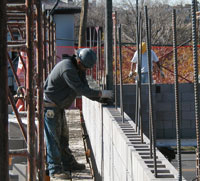 For a long time, the Masonry Standards Joint Committee, referred to as the MSJC, was responsible for developing and maintaining the Building Code Requirements for Masonry Structures and the Specification for Masonry Structures. These two documents and the commentaries to them were joint efforts of the American Concrete Institute (ACI), the Structural Engineering Institute of the American Society of Civil Engineers (SEI of ASCE), and The Masonry Society (TMS).
For a long time, the Masonry Standards Joint Committee, referred to as the MSJC, was responsible for developing and maintaining the Building Code Requirements for Masonry Structures and the Specification for Masonry Structures. These two documents and the commentaries to them were joint efforts of the American Concrete Institute (ACI), the Structural Engineering Institute of the American Society of Civil Engineers (SEI of ASCE), and The Masonry Society (TMS).
In late 2013, ACI and SEI released their rights to future editions of these publications, making TMS the sole sponsor. The documents are now known as TMS 402/602.
Building Code Requirements for Masonry Structures (TMS 402) covers the design and construction of masonry structures. It is written in language to make it easy to adopt by reference by a legally adopted building code. It covers numerous subjects, including: contract documents; quality assurance; materials; analysis and design; strength and serviceability, loads; reinforcement; seismic design requirements; glass unit masonry; and veneers. Empirical design, strength design, and allowable stress design are also covered.
The counterpart to the code is the specification, Specification for Masonry Structures (TMS 602). This document serves a different purpose, namely, to control materials and construction. It covers minimum construction requirements for masonry in structures; these may be supplemented by specific project requirements. Quality assurance is a focus of the document, such as the placing, bonding, and anchoring of masonry, and the placement of grout and reinforcement.
The Code and Spec are generally published on a three-year cycle and are available for purchase from The Masonry Society.